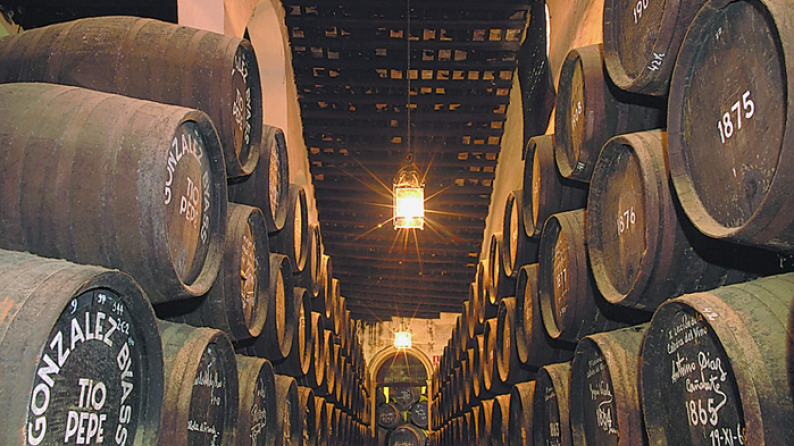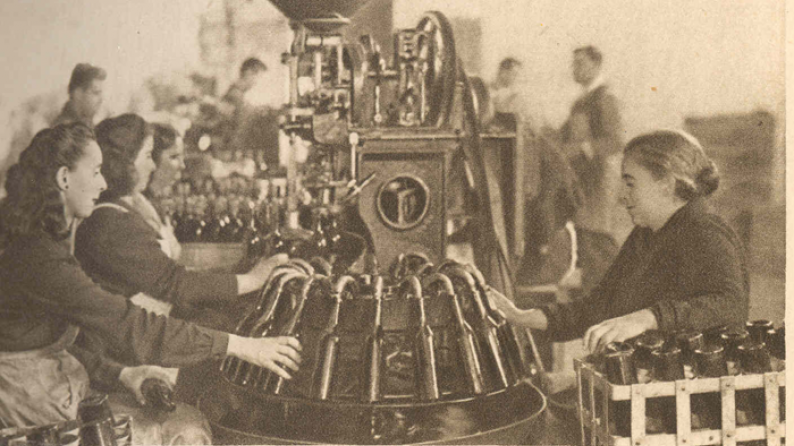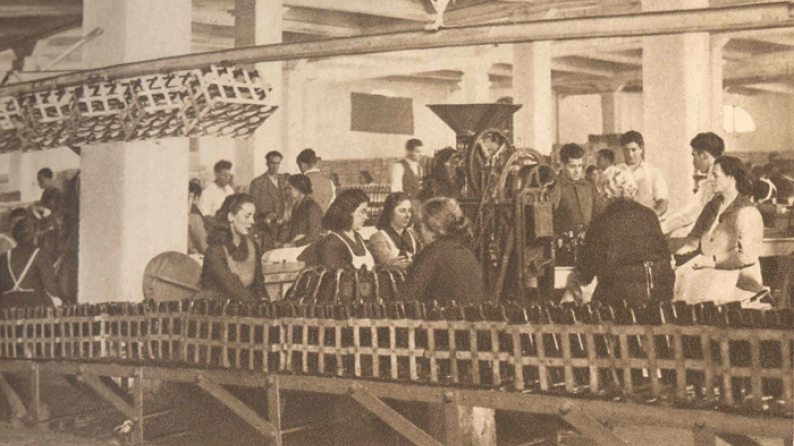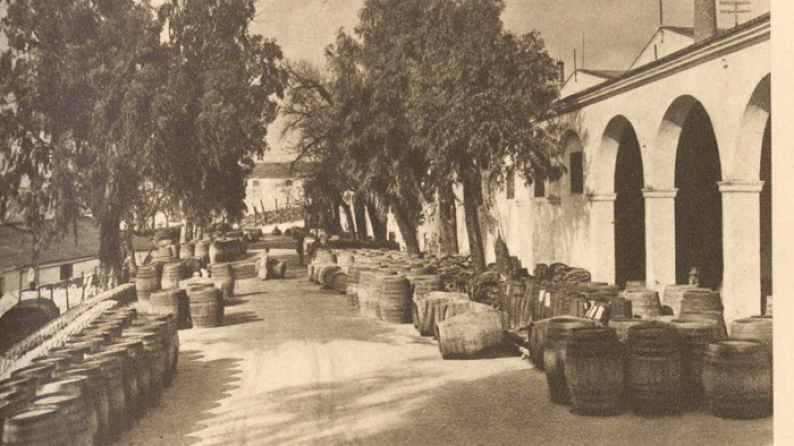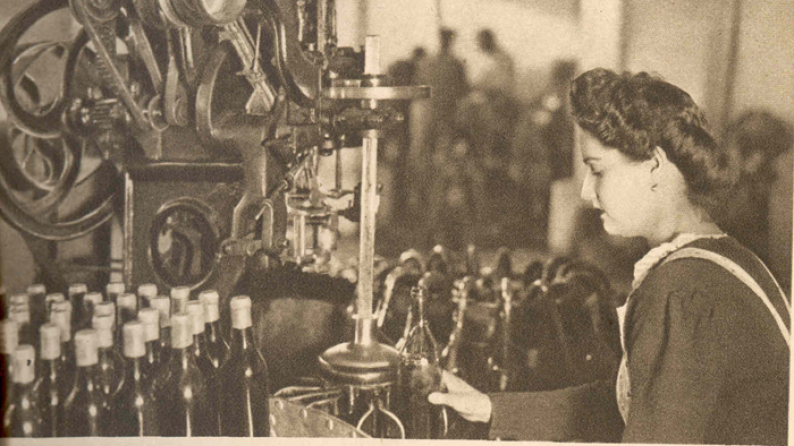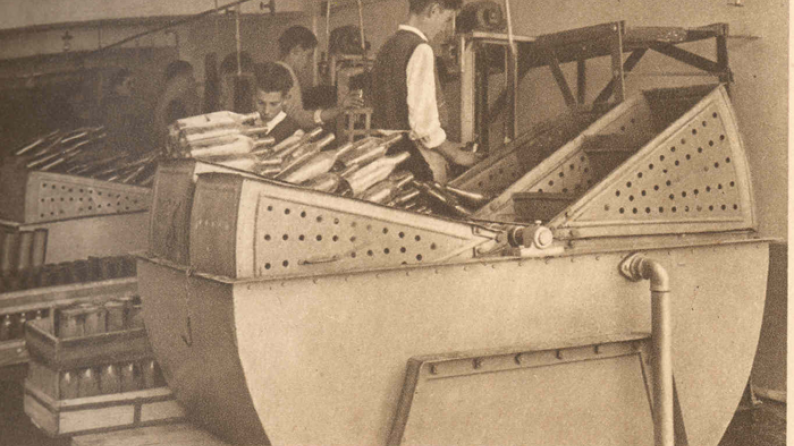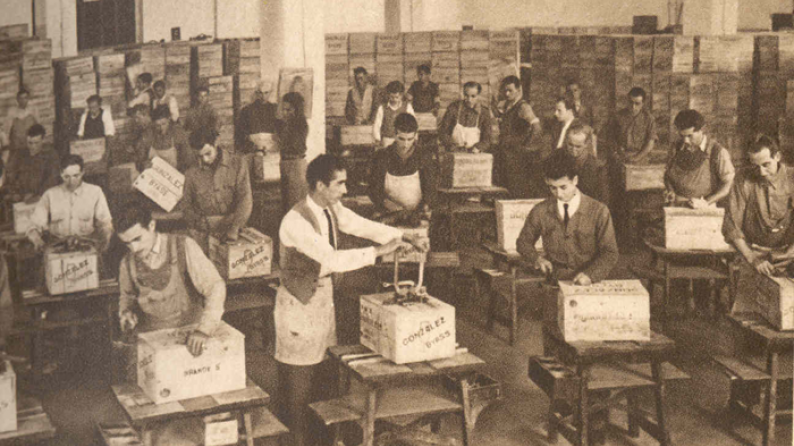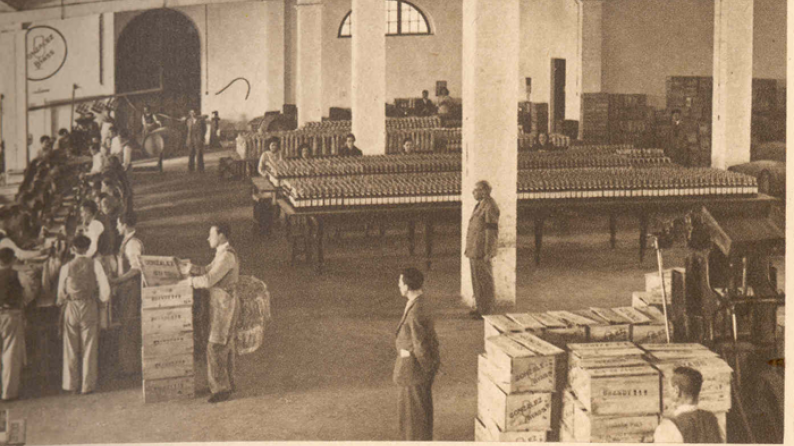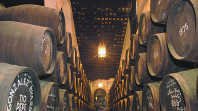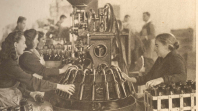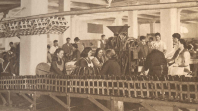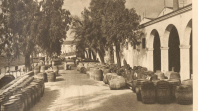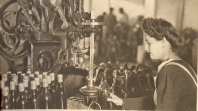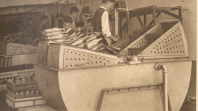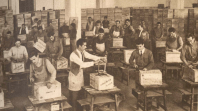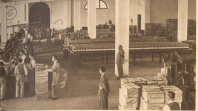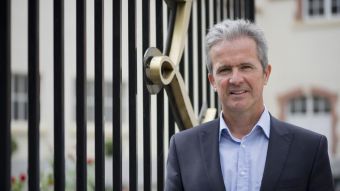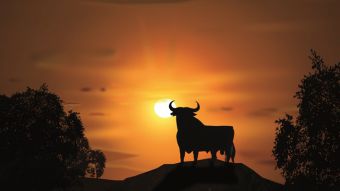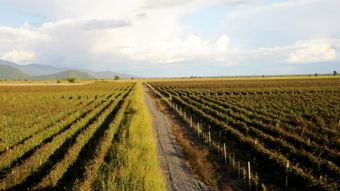González Byass. Tío Pepe and La Pepa
The founder of this famous sherry bodega was born in the village of Sanlúcar de Barrameda, in the province of Cadiz, in the same year that the 1812 Constitution, known as La Pepa, was enacted. But this is mere coincidence and not the reason why the most international of the bodega’s sherries was christened “Tío Pepe”. Its name is in fact associated with a relative of the founder, a maternal uncle named José, who played an important role in the development of the bodega. It is to him that the famous fino sherry was dedicated.
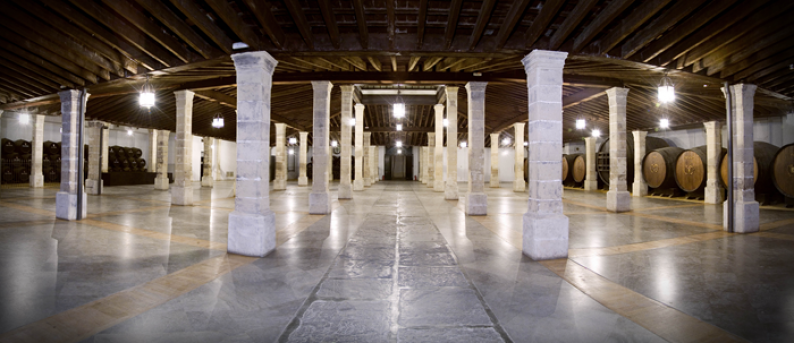 Spectacular picture of the Los Apóstoles bodega supported by 56 columns
Spectacular picture of the Los Apóstoles bodega supported by 56 columns
Life is full of surprises. Manuel María González Angel who, in 1835, founded the González Byass company, which went on to become one of the most important in Jerez today, was closely associated with Sanlúcar de Barrameda. Sanlúcar is of course the capital of manzanilla sherry, the delightful sibling to fino sherry, but which many consider to be its rival. In the past, bodega owners in both Jerez and Sanlúcar even waged wars against each other, which were absurd, as fino and manzanilla are brothers, practically twins!. Both are of great quality, share a regulatory board and are produced in the same area with only a few kilometres separating or uniting them (whatever your point of view).
Born in 1812, Manuel María was the son of José Antonio González Rodríguez. The family names lacked glamour but befitted a second lieutenant of the cavalry and guardia de corps (royal guard), part of the military elite to which admission was difficult. As well as being tall and well built, you had to be fairly rich, of course – the criteria were strict!
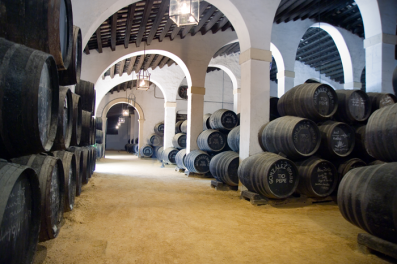 In the late 18th century José Antonio was sent to Sanlúcar de Barrameda to oversee and administer the monies derived from the sale of salt, taking up the post of “Visitador General de las Rentas de Salinas” (inspector general of salt revenue). The salt flats at the mouth of the Guadalquivir River, opposite the famous Coto Doñana wetlands, were the town's main source of wealth for centuries. In those days salt was a very valuable raw material due to its many uses, including the preservation of food. So José Antonio arrived in the town of Sanlúcar, a 31 year old bachelor, with his good looks and nice manners.
In the late 18th century José Antonio was sent to Sanlúcar de Barrameda to oversee and administer the monies derived from the sale of salt, taking up the post of “Visitador General de las Rentas de Salinas” (inspector general of salt revenue). The salt flats at the mouth of the Guadalquivir River, opposite the famous Coto Doñana wetlands, were the town's main source of wealth for centuries. In those days salt was a very valuable raw material due to its many uses, including the preservation of food. So José Antonio arrived in the town of Sanlúcar, a 31 year old bachelor, with his good looks and nice manners.
There he wed an angelic señorita from Sanlúcar by the name of Rosario Ángel (her surname suited her kind nature), who was almost twenty years his junior. They had seven children and the youngest was born in the spring of 1812, at the time when the Spanish Constitution, referred to as La Pepa, was being enacted in the Courts of Cadiz. They named him Manuel María, and he is at the centre of our story, along with José, the maternal uncle, always ready to lend Manuel María a helping hand and who was much loved in return. Uncle José was the famous Tio Pepe (Uncle Joe), after whom the internationally famous fino sherry brand was named.
A true merchant
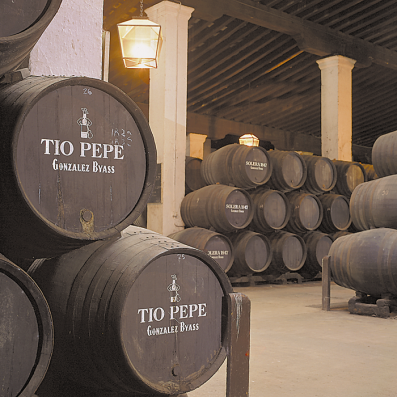 They did not permit Manuel María González Ángel to undertake the long studies required to become a doctor or a lawyer, as they had his siblings, apparently due to his poor health. He was only allowed to study commerce, which he proved to be exceptionally good at. Had he become a doctor, he would have saved many lives, but then González Byass, one of the finest sherry bodegas in the world, would never have existed. After the death of his father, when Manuel María was 20 years of age, he went to work in Cadiz, the provincial capital. Cadiz at the time was an important city at the height of its glory and at the centre of overseas trade with the new American colonies. It was virtually the commercial capital of Spain.
They did not permit Manuel María González Ángel to undertake the long studies required to become a doctor or a lawyer, as they had his siblings, apparently due to his poor health. He was only allowed to study commerce, which he proved to be exceptionally good at. Had he become a doctor, he would have saved many lives, but then González Byass, one of the finest sherry bodegas in the world, would never have existed. After the death of his father, when Manuel María was 20 years of age, he went to work in Cadiz, the provincial capital. Cadiz at the time was an important city at the height of its glory and at the centre of overseas trade with the new American colonies. It was virtually the commercial capital of Spain.
The young Manuel María went to work for the Lasanta company where his determination, intelligence and work ethic soon got him noticed. But Manuel María had one goal in mind, to get rich, and he worked tirelessly in order to achieve this. Not long after he arrived in the town, he had married Victorina, a young lady from a respectable and wealthy Cadiz family. During the course of his work, he noticed the stock of sherry butts (casks) sitting in the port of Cadiz. At that time, sherry was starting to be exported to England and other countries.
This was in 1834 and the Gremio de la Vinatería, the vintners guild which, up until that time, had prevented the ageing of sherries, had already been dissolved. It occurred to Manuel María that buying and exporting sherry was the business to be in, and he therefore decided to set up as an exporter, but not produce sherry himself. He bought a batch of wines in Sanlúcar de Barrameda, the town where he had been born and raised and where he naturally had contacts. He rented a small premises in a neighbourhood, far from where the bodegas are located today, and he bought the equivalent of 10 casks to export to England, where sherry was already a prestigious beverage.
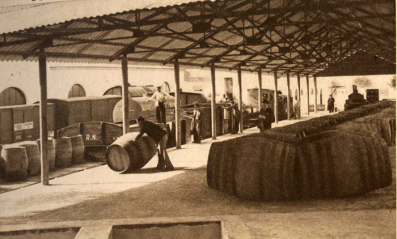 Old photo of the docksideBefore carrying out the operation, Manuel María wisely contacted one of his childhood friends from Sanlúcar, then living in London, where his father was posted. The friend’s name was Juan Bautista Dubosc. Manuel María loaded the 10 casks onto a ship named Brilliant, which his friend had recommended because it was owned by a very wealthy English ship owner, who also happened to be an important wine merchant in Great Britain. His name was Robert Blake Byass.
Old photo of the docksideBefore carrying out the operation, Manuel María wisely contacted one of his childhood friends from Sanlúcar, then living in London, where his father was posted. The friend’s name was Juan Bautista Dubosc. Manuel María loaded the 10 casks onto a ship named Brilliant, which his friend had recommended because it was owned by a very wealthy English ship owner, who also happened to be an important wine merchant in Great Britain. His name was Robert Blake Byass.
The start of the "Company"
The company which exported these first 10 casks was called Manuel González and the wines were pale, golden and brown, the types popular in the British market at the time. Business must have been quite good because Manuel María decided to go into partnership with a friend from Sanlúcar who had supplied the sherry, and his other friend from Sanlúcar who had provided the contacts and support in England.
The company was renamed Manuel María González y Cia., and later renamed González Dubosc, when one of the partners, the one who had supplied the sherries, decided to sell his stake and withdraw from the company. Obtaining the money to buy him out was no easy matter, but they were able to do so.
Their sherry sales were growing and they realised that they needed an exclusive distributor for Great Britain, and who better than the famous Byass, the wealthy owner of the ship which had carried the first 10 casks. They convinced him to work with them but, although he wanted a stake in the company and they needed the money because they were investing heavily for the time, the two friends and partners, Dubosc and Gonzalez, only allowed him to become an agent and distributor.
They were still just buying and selling sherry at the time. Manuel María moved from Cadiz to Jerez and began to think about creating a bodega to produce their own sherry. He bought up several premises and cellars in the area close to the cathedral, where the headquarters of Gonzalez Byass are located today. At the time these plots and premises were in small urban streets, but now these streets are part of the bodega’s premises.
Tio Pepe and fino sherry
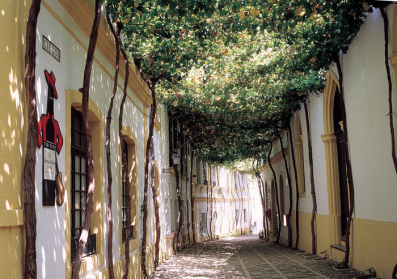 Calle Ciegos, in Jerez de la Frontera, owned by González ByassWe are now in 1840 and fino sherry was still only being enjoyed by the locals and not yet exported. Manuel María’s uncle Pepe, who had always been generous with his help, but who, until then, had not become directly involved in the company, insisted they send Byass, the English agent, a batch of pale, dry wine, i.e. the fino sherry, hitherto unknown outside the local area. And it was a hit. Manuel Maria gave his beloved uncle Pepe one of the bodegas, which he had acquired from a priest, so that he could make the finos he loved so much. Today this quiet bodega is the one known as “la bodega del Tio Pepe“ and is presided over by a portrait of the beloved founding uncle. The brand could not be protected until 35 years later, as registration did not exist until then.
Calle Ciegos, in Jerez de la Frontera, owned by González ByassWe are now in 1840 and fino sherry was still only being enjoyed by the locals and not yet exported. Manuel María’s uncle Pepe, who had always been generous with his help, but who, until then, had not become directly involved in the company, insisted they send Byass, the English agent, a batch of pale, dry wine, i.e. the fino sherry, hitherto unknown outside the local area. And it was a hit. Manuel Maria gave his beloved uncle Pepe one of the bodegas, which he had acquired from a priest, so that he could make the finos he loved so much. Today this quiet bodega is the one known as “la bodega del Tio Pepe“ and is presided over by a portrait of the beloved founding uncle. The brand could not be protected until 35 years later, as registration did not exist until then.
The company was doing well and was already one of the leading producers and exporters of sherry, when the founder finally decided to allow Mr. Byass to become a partner, in 1855. The company later acquired the name it has today, Gonzalez Byass.
During this period, they started to have their bottles manufactured in Spain and to label their sherries in a rudimentary fashion. Manuel María also started the construction of their first totally new bodega known as la Constancia. He had already bought up some small existing bodegas and plots close to the cathedral, as we mentioned earlier. Within a few years the company’s bodegas included “La Cuadrada“, with exact measurements of an “aranzada“ (4,472 square metres), “Los Apóstoles“, and the famous “La Concha“ (attributed to Eiffel), each of great architectural value, in various styles, from different eras. All surrounded by beautiful tropical gardens, making González Byass one of the most beautiful wine locations in the world.
One of Manuel María González’s sons, Pedro Nolasco, Marqués de Torre Soto, inherited his direct responsibilities and then, in turn, another of his sons, Manuel María González Gordon, Marquis de Bonanza, took over. Manuel María González Gordon was a wise man, much loved in Jerez, an outstanding researcher and a mechanical engineer, who was able to use his training to modernize the bodega's facilities, which were already of considerable size. He also wrote the best book ever published on the subject of sherry, regarded as the Sherry Bible.
In1988, the Byass family decided to withdraw from the company, so today, with the exception of two distributors, one in Japan and the other in Switzerland, who have small shareholdings, the business is fully owned by the Gonzalez family. Manuel María González Gordon’s son, the late Mauricio, took over the management of the company until he in turn, handed over to his son, also named Mauricio, who is the company’s chairman today.


